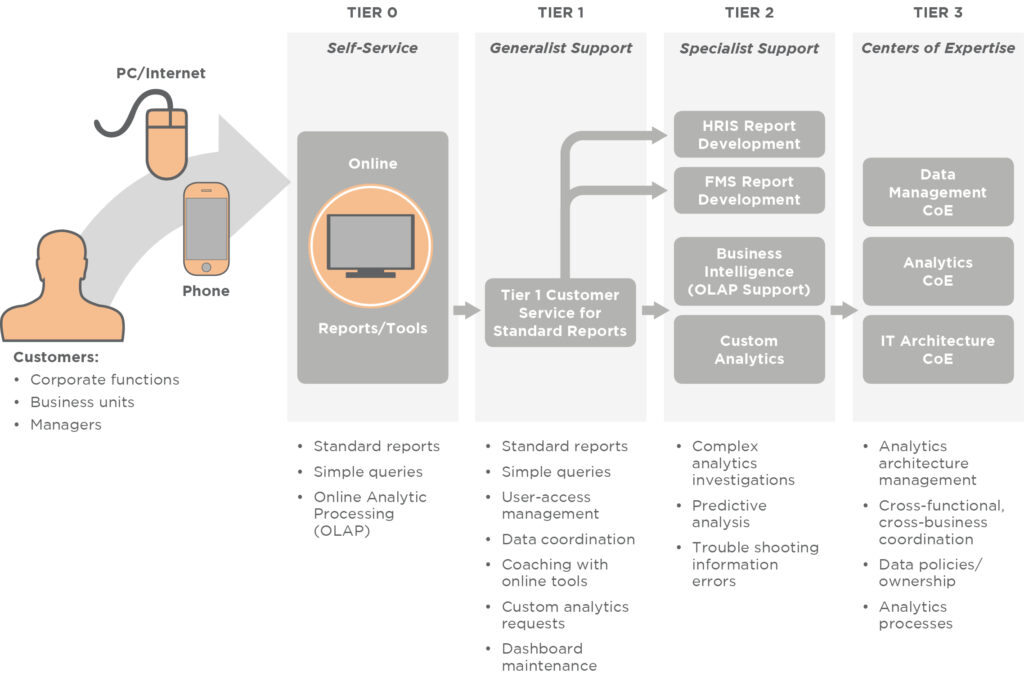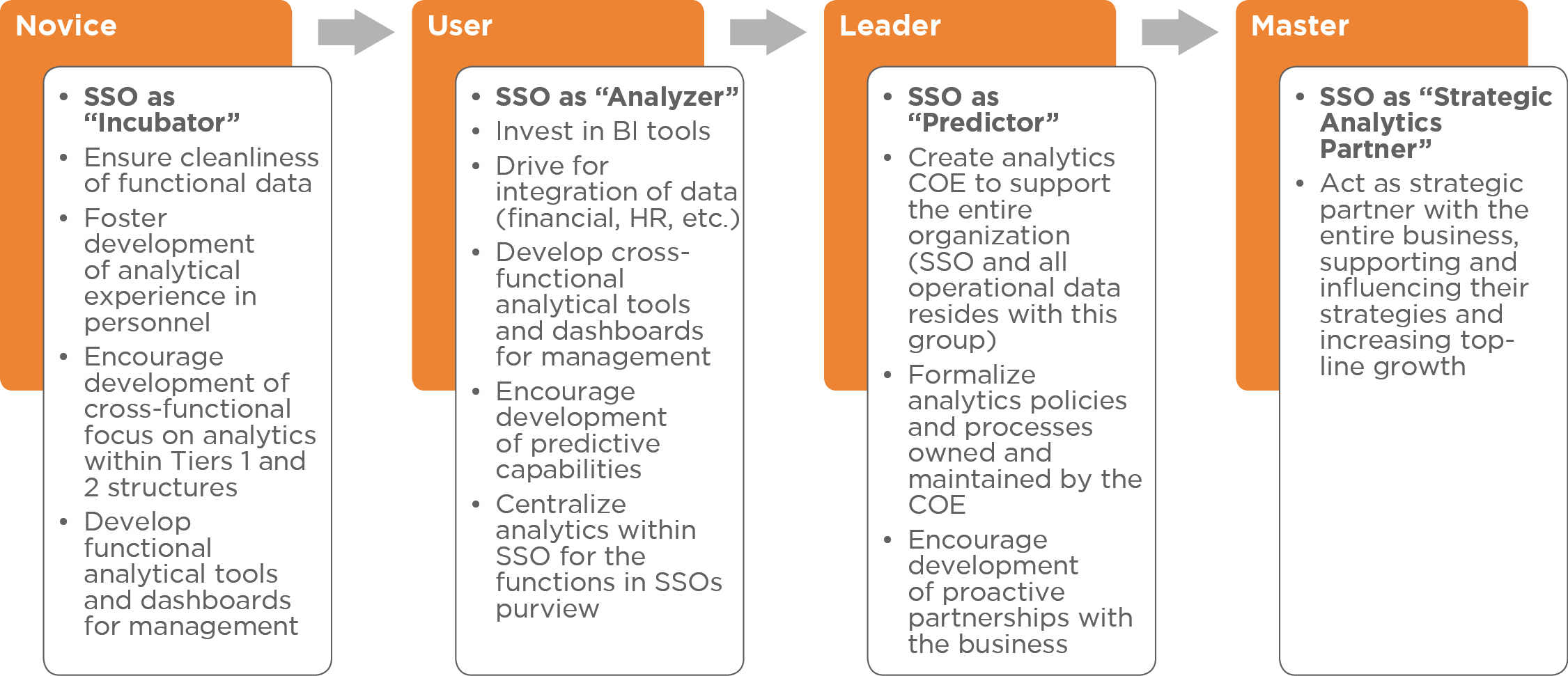
More than ever organizations understand the value effective analytics can have on their businesses. Most organizations face two primary obstacles in realizing the value of analytics: the lack of technology integration and the inability to secure and develop the right talent. Many companies are investing in predictive analytics capabilities, but they are still in the early stages of maturity. We found that only a few companies have been able to make the necessary investments to successfully overcome these obstacles and reach the end-state benefits so often attributed to effective use of predictive analytics.
ScottMadden believes Shared Service Organizations (SSOs) can accelerate the development of analytics capabilities within companies. SSOs can provide the ideal structure to climb the value curve from simple metrics reporting to actionable insight that managers and leaders need. Multi-function SSOs have greater access to the cross-functional data required to conduct multi-variant analyses. Often, they have invested in foundational reporting platforms that can support a quicker transition to more complex analytical tools and infrastructure required to support effective analytics. Finally, SSOs can afford the scale and focus to acquire highly skilled resources required to formulate and test various business hypotheses. By installing these experts in SSOs, businesses spread the cost of making these services affordable. We believe the SSOs provide the optimum structures within companies to build and provide analytics services.
SSOs that provide HR, Finance, IT, Procurement, Facilities, and/or other services in their portfolios can consolidate information which can facilitate crossfunctional analyses. This ability to use data from various functions supports effective multi-variant analyses, and it enhances business decision-making by evaluating options and impacts across functions rather than within silo-ed functions/departments. Thus, SSOs can provide value-added insight to businesses across functions/departments (e.g., impact of employee turnover on profit margin ratios).
In addition, many SSOs have developed a robust reporting foundation to provide transactional reporting services to businesses, while also enabling SSO operational transparency in support of Service Level Agreements (SLAs) and charge-back methods. This reporting bench strength can serve as a mechanism for elevating performance, shifting SSOs from providing metrics to strategic analytics. ScottMadden believes SSOs could pilot workforce planning within HR or an order-to-cash analytics within Finance as starting points.
Beyond the reporting bench strength, the technical interfaces and integration that is required to drive the evolution can also be supported via SSOs. With many SSOs including IT in their portfolios, they can influence the technical architecture and define the integration strategy of disparate technology and data sources. As examples, effective analytics require enterprise data warehouses (EDW)/data marts, analytics software, or other strong business intelligence (BI) tools that can interface with multiple platforms and other technologies to support analyses of structured and “unstructured” data (e.g., comments/reviews on Facebook, product reviews via Twitter, etc.). These efforts to integrate technology can benefit from a consistent vision and planning of the IT architecture to enable the success of analytics. SSOs, by virtue of their ability to influence IT and understand the business needs, are uniquely positioned to encourage such technology integration efforts.
ScottMadden views the conceptual end-state model for analytics as a series of tiered services ranging from the simple, standard metrics reporting to simple analytics to the more complex, predictive analytics.
Metrics reporting and analytics would be consumed by the organization as services from the SSO. The delivery model would follow a tiered structure similar to the one described below:
• Tier 0 and Tier 1 – Simple, standard metrics reporting and pre-configured analytical tools would be available and managed through self service portals (links, dashboards, and analytical tools) and via “generalist” support for such queries.
• Tier 2 – Queries requiring more complex analyses, including predictive analyses, would be supported by analytical “specialists” within the SSO, as these queries would require greater skill with BI tools as well as deeper experience in analytics, hypotheses formulation, and analytical storytelling. These “specialists” would support business units and departments and be cross-functionally focused to ensure analytics leveraged insights from across the business. Only a few would focus on specialty areas as needed by the business, both functional (e.g., Human Resources Information Systems – HRIS) and technical (e.g., BI Online Analytical Processing – OLAP).
• Tier 3 – A Center of Expertise (COE) would establish the direction of predictive analytics in the organization and enable the SSO to adapt the tools and skills to meet the changing analytical demands of the organization, acting as a strategic partner for the company. In addition to an analytics COE, additional policy-making bodies would be required to ensure the overall IT architecture and data management strategy were defined and supported to enable effective analytics.
Such a conceptual model is shown in Figure 1 with a highlight of key responsibilities at each tiered level of service.
Organizations are currently at various stages of analytical maturity. Several may have already started down a path of improvement without leveraging their SSOs. ScottMadden believes, however, that there is a role for SSOs to play at every stage of the maturity curve, and SSOs can accelerate the rate of evolution for organizations.
Figure 2 shows ScottMadden’s perspective on how SSOs can help drive analytics expertise in their organizations, using the ScottMadden Analytics Maturity Model stages as reference points.
While the road map to achieve increasing levels of analytics capabilities can help, there is still a long way to go for most companies. As most organizations start on this journey, there are a few key activities SSOs can begin to work on now to position themselves appropriately:
• Pilot analytically driven initiatives that leverage your current SSO functional expertise. Identify an opportunity to showcase how your SSO can effectively support analytics for the rest of the organization via a pilot (e.g., workforce planning in HR).
• Start development of analytically minded individuals in your organization. Leverage the reporting teams in your SSO to identify those employees most able to move beyond “scorekeeping” and into “storytelling.”
• Recruit analytic groups from within the organization. Sell the benefits of a centrally managed analytics “COE” in your organization and begin to pull these groups into your SSO.
• Identify one to two technology integration points for your organization in 2013. Influence and identify one to two technology platforms whose integration will dramatically increase crossfunctional analytic capabilities. Focus on targeted activities that can help integrate data (e.g., via EDW) rather than long-term integrations (e.g., combining multiple Enterprise Resource Plans).
• Invest in robust, platform-agnostic BI tools. Leverage current SSO reporting requirements to further advance the need for robust BI tools, which will support future analytic capabilities.


ScottMadden believes there is a great opportunity for companies, and SSOs in particular, to drive and improve their analytics capabilities. With more and more organizations believing that analytics can provide them with improvements in productivity and profitability, and with greater availability of data from all sorts of sources, the time to make analytics a competitive advantage for you may indeed be now.
View MoreSussex Economic Advisors is now part of ScottMadden. We invite you to learn more about our expanded firm. Please use the Contact Us form to request additional information.